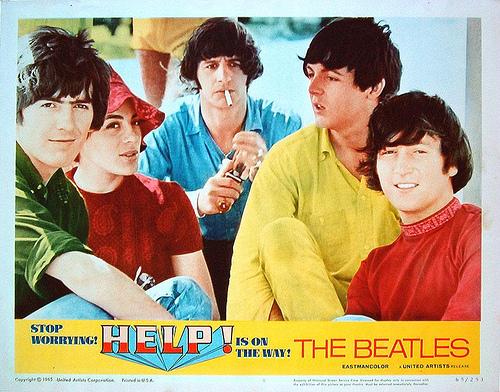This Week in Movies & TV, June 25, 2013: Two Foot Small

Help!
The title song, Help!, kicks in beautifully - thrillingly - with snaredrums somewhere in the room up left, vocals in center, lead guitar in the surrounds - glorious. Whenever the film launches into one of its seven classic numbers (only seven?) in 5.1 channels the band leaps into the room filling the soundstage and bringing everything to life. "You're Going to Lose That Girl" ("yes, yes you're gonna lose that girl") - vocals center, drums once again front left, rhythm guitar in right, congas in surrounds. Magic. The direction by Dick Lester at these times is especially inventive and experimental.
In addition there's covers of A Hard Day's Night album tracks - an orchestrated version of "You Can't Do That," given a John Barry-ish Bond music-like arrangement, a brass band take on "I'm Happy Just to Dance with You,"and "A Hard Day's Night" played by an Indian band. They're not as three-dimensional as the performed songs - few things are - since it is supposed to be background music, but instrumentation is still well separated. Utterances like "I am not what I seem!" from the center channel are clear and sonorous. "You've Got to Hide Your Love Away"- Ringo Starr's tambourine and lead guitar in surrounds, rhythm in left front. Incredibly satisfying mixes, "Ticket to Ride," "The Night Before," and "Another Girl" all sounding sensational.

Help! (1965) was completely digitally restored in 2007. Contrast in the bright 1.67:1 picture is good with rich blacks, like John's rollneck, fairly bright white Beatle collars and skiing slopes, and well-defined rich greens in George's pajamas and Eleanor Bron's sari. Her all-pink outfit with matching gun is equally saturated, as are the reds in the Indian bad guy's uniforms and the all-important sacrificial ruby ring on Ringo's finger. There's not much tonal variation, though, especially noticeable in skin, which tends to be unvariegationally brownish - more than just even tans - and some exterior shots of swinging London are faded. Otherwise everything looks fab.

Images have great depth and plentiful detail revealing strands of Ringo's mop-top and locks of Paul's do, the individual grill on a microphone, and wisps of cigarette smoke. Scratches in a pot (not that kind) are visible and Bahaman sands have texture as do the rough woolen army uniforms. "I Need You" - volume-pedaled, quasi-modal guitar and chorus in surrounds, George's double-tracked vocal in center. Life comes alive. And you can see the hairs on his fingers while he plays.
A must have.
Video: 1.67:1. Audio: LPCM 2.0, DTS-HD Master Audio 5.1. Extras: "The Beatles in Help!," "Memories of Help!," and "The Restoration of Help!" featurettes, interviews about a scene that ended on the cutting-room floor, Digipackaging featuring reproductions of posters and lobby cards and remembrances by Lester and Martin Scorsese. Studio: Universal Music.

Upside Down 3D
In an alternate universe where two Siamese-twinned worlds have opposite gravities, Adam (Jim Sturgess) is an ordinary guy who lives on the impoverished planet Down trying to make ends meet, while on the other world, Up - an inverted affluent world with its own gravity - is a girl named Eve (Kirsten Dunst) whom he once met while climbing a mountain as a youth, a girl he's never been able to forget.
The gravity of the planets have 3 rules: 1. All matter is pulled by the gravity of the world that it comes from and not the other. 2. An object's weight can be offset by matter from the opposite world (inverse matter). 3. After some time in contact, matter in contact with inverse matter burns.
Going to Up or even having contact with anyone from Up is strictly forbidden on Down and is punishable by imprisonment or even death. But when Adam catches a glimpse of grown-up Eve on television, despite it being an impossible love, will go to the ends of the World - his or hers - to get her back in his life. Now he must fight not only interplanetary prejudice, but the very laws of physics to see her and prove that love is stronger than gravity.
This French-Canadian romantic sci-fi drama is written and directed by Juan Diego Solanas and co-stars Timothy Spall, Stella Maeve, and Neil Napier.
Upside Down is also available in a 2D Blu-ray set that comes with a DVD and UltraViolet digital copy for streaming/downloading.
Video: 2.40:1. Audio: Dolby TrueHD 5.1, Dolby Digital 2.0. Extras: making-of featurette, deleted scenes, "History of the World" storyboarded alternate opening, preliminary sketches, tango storyboards, missing forest storyboards, Sage Mountain previz, office previz, final shot previz; 2D Blu-ray, DVD. Studio: Millennium Media.

Inspector Lewis: Series 6
Inspector Lewis is a highly popular British TV murder mystery detective drama series made as a spin-off, in 2006, from Inspector Morse in which Robert Lewis (Kevin Whately) was Morse's sergeant. Now Lewis, promoted to Detective Inspector (DI) Lewis, has his own assistant - Detective Sergeant (DS) James Hathaway (Laurence Fox). Their beat is primarily Oxford, a university town - the university town (unless you went to Cambridge) - where easygoing, working class Geordie (from North East England) Lewis, is somewhat lost amongst the intellectual scholars. Fortunately Hathaway is a cerebral, highly knowledgeable Cambridge graduate who then trained in Theology at Oxford in order to become a priest. It's often up to him to translate from Latin, explain an obscure historical reference, or decode a scholarly literary quote they come across in the course of their investigations within the ivy-covered academia.
Lewis was a family man but his wife got killed in a hit and run car accident, so now he throws himself into his work. Although an opera lover and with a passion for all classical music, Lewis is a down-to-earth, plain speaking hater of snobbery and is often irked by the arrogance of Oxford dons and their students. His uncanny instincts and common sense worldly wisdom complement and cut through the esoteric puzzle-solving of his DS.
Hathaway is a very private person, often making his feelings and past as much of a mystery as the murder the team are investigating. This can cause some tension between the two but not as much as that between Lewis and equally workaholic forensic pathologist Dr. Laura Hobson (Clare Holman). But their tension has more of an unspoken, unfulfilled romantic nature. And then there's the more professional problems he has with The Guv - Chief Superintendent Jean Innocent (Rebecca Front) who, though supportive, often questions his methods in order to push along the investigation to resulting collars and to prevent this rough diamond from ruffling the feathers of influential establishment figures of Oxford.
Whately has been playing Lewis since 1986 - most of his adult life. But Series 6 is possibly his last! It brings three new feature-length mysteries on two discs for Lewis and Hathaway to investigate - "Down Among the Fearful," "The Ramblin' Boy," and "Intelligent Design."
In "Down Among the Fearful" a research fellow from an Oxford college's Department of Psychology, Reuben Beatty, is found dead in the offices of psychic Randolph James. But Lewis and Hathaway soon discover that the psychic and the psychologist are one and the same man.
"The Ramblin' Boy" finds Hathaway vacationing in Kosovo while Lewis has to break in young constable Alex Gray who he's temporarily assigned. Despite the absence of the irreplaceable Hathaway, Lewis must solve the strange case involving a body that's already embalmed. What's more, the killer turns out to be cancer. And according to records, the dead man's supposed to already have been cremated. So who was actually burnt?
In "Intelligent Design" a former biochemistry professor is murdered - crushed to death by his own car - after recently being released from prison after killing someone in a driving accident.
The series and characters were inspired by the Inspector Morse novels of Colin Dexter.
Video: 1.78:1. Audio: Dolby Digital 5.1. Extras: none. Studio: PBS.

Shoah
It took over a decade to make and even longer to get over, but Claude Lanzmann's 1985 nine-hour-plus document of inhumane men's inhumanity to those they didn't recognize as their fellow men, women, and children is a monumental testimony to the more than six million Jews systematically eliminated from life and the planet by the Nazis regime and its followers.
Instead of the typical portrayal of the Holocaust with archival footage of skeletal corpses and the staring near-dead, director Claude Lanzmann chose instead to collect first-person interviews with the survivors, killers (including guards and other former Nazis involved and implicated), and witnesses, using a free-associative method. He also visited key sites across Poland, including three extermination centers, focusing on Che?mno (where mobile gas vans were first used to exterminate Jews), the death camps of Treblinka and Auschwitz-Birkenau, and the Warsaw Ghetto.
Shoah was hailed as a masterpiece on its release, and one of the most important cinematic works of all time.It comes in a new high-definition digital restoration with uncompressed monaural sound.
If this 550-minute film gives you a taste for more of Lanzmann's work, then look no further because three additional films by him are included in the set: A Visitor from the Living (1999, 68 minutes), Sobibor, October 14, 1943, 4 p.m. (2001, 102 minutes), and The Karski Report (2010, 54 minutes) - amazing extras.
Video: 1.33:1. Audio: French, Italian, Polish, German, English, Hebrew, and Yiddish, Linear PCM Mono with English subtitles. Extras: 3 additional films by Lanzmann - A Visitor from the Living, Sobibor, October 14, 1943, 4 p.m, and The Karski Repor, new conversation between critic Serge Toubiana and Lanzmann, interview with Lanzmann about A Visitor from the Living and Sobibor, new conversation between associate director of photography Caroline Champetier and filmmaker Arnaud Desplechin, booklet featuring an essay by critic Kent Jones and writings by Lanzmann. Studio: The Criterion Collection.

Phantom
What happened when a Soviet submarine, armed with nuclear missiles, went missing in the Pacific at the height of the cold war? Phantom - a thriller loosely based on the real-life events involving the K-129 crisis of 1968 in which the world waited with baited tenterhooks while the sub's captain held mankind's fate in his gloves - answers that question. Demi (Ed Harris), a veteran Navy captain winding down his career but still living in the deep dark shadow of his legendary father, is given command of his old ship for a top-top secret mission ordered by Markov (Lance Henriksen). On board the sub Demi finds that he has to deal with some less-than-welcome passengers - KGB agent Bruni (David Duchovny) and a group of his men.
Once at sea, Bruni informs Demi at gunpoint that there will now be a new mission, the objective of which is to start a war between the United States and China. He and his men intend to do so by using a device known as The Phantom to alter their ship's identifying marks to make the vessel appear to be a Chinese - like wearing a Charlie Chan moustache - and launching a nuclear missile at the American fleet.
Demi, his executive officer, Alex Kozlov (William Fichtner), and the men remaining loyal to Demi are locked away. With enemy forces closing in and time running out, they must plot their escape so that they can eventually take back the ship and foil the rogue KGB agents' plot that could lead to nuclear Armageddon!
Phantom was written and directed by Todd Robinson (writer of White Squall, and director of Lonely Hearts, The Legend of Billy the Kid and Wild Bill: Hollywood Maverick, a documentary on director William A. Wellman) and co-stars Johnathon Schaech, Jason Beghe, Sean Patrick Flanery, Jason Gray-Stanford, and Julian Adams.
Video: 2.40:1. Audio: DTS-HD Master Audio 5.1. Extras: commentary, "Facing the Apocalypse," "The Real Phantom," and "Jeff Rona: Scoring the Phantom" featurettes, "An Ocean Away" music video; UltraViolet digital copy for streaming/downloading. Studio: 20th Century Fox.

No
In 1988, facing considerable international pressure, Chilean military dictator of fifteen years General Augusto Pinochet calls for a plebiscite, a referendum by Chilean citizenry on his presidency to decide whether he should have another 8-year term as President or whether the following year there should be an open democratic presidential election.
In an unusual move, leaders of the opposition "No" committee decides to consult a successful young advertising executive René Saavedra (Gael García Bernal) to spearhead their campaign. Behind the back of his politically conservative boss, Saavedra, intrigued by the challenge, agrees to come on board but, unfortunately, the advertising they wish to push is an unappetizing, unappealing record of the regime's abuses.
With limited resources and under the constant scrutiny of Pinochet's watchmen, Saavedra and his team conceive of a crazy plan to free their country from oppression: using advertising techniques and tactics to win the election. Saavedra proposes that, to overcome concerns that voting under a brutal military junta is pointless and suicidal, they should take a lighthearted, upbeat promotional approach - stressing abstract concepts like "happiness" and using street concerts and Hollywood celebrity spots by Jane Fonda, Christopher Reeve, and Richard Dreyfuss - to challenge the regime and sell the "No."
This true story - turned into an unpublished play El Plebiscito written by Antonio Skármeta and then into a screenplay by Pedro Peirano - was directed by Pablo Larraín (director of Post Mortem and Tony Manero and producer of 4:44 Last Day on Earth, The Year of the Tiger, and Young and Wild).
No was nominated for an Oscar for Best Foreign Language Film.
Video: 1.37:1. Audio: Spanish DTS-HD Master Audio 5.1. Extras: commentary by García Bernal and Larraín, Q&A with García Bernal. Studio: Sony.
- Log in or register to post comments






























































